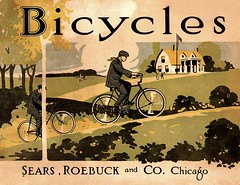Speaking of bicycling

The WashCycle blog on area biking issues has two good entries that caught my attention. The first is about Montgomery County's work on revising their current planning framework towards a more citified format (MoCo has been working with Project for Public Spaces, and one higher level staffer attended the same "How to Turn A Place Around" workshop I attended last May).
I haven't written about this because, well, because I care more about DC. But WashCycle focuses on the bicycling aspects and makes good general points that tie into good neighborhood and mobility planning irrespective of place.
He writes that the plan "Provid[es] pedestrian and bicycle amenities such as bike racks and lockers, special pavement and lighting so that non-motorized people know they are welcome... [and recognizes that] narrow sidewalks are not bicycle friendly."
His response is right on:
Bikes do not belong on sidewalks. It's dangerous for cyclists and pedestrians - so they talk about bicycle sidepaths (which I don't care for unless there really is no other option) and bike lanes. But they're still missing critical elements.
They need to start from the bottom up. They need to make sure they don't force out small neighborhood bike shops with big box retailers. They need to provide not just parking, but shower facilities, bike maps, and bike related signage. They need to think about bike rentals. If they build bike lanes - they need to be wide with room in the door zone. And they need to integrate bikes into rail and bus transit as well as roads. They're plan is still too road centered in my opinion. But it's a good point to start from.
Thanks for reminding us to not forget about bicycling planning as a fundamental piece of comprehensive planning at all times. I continually raise the point that if DC required transportation demand management planning as part of zoning regulations for commercial buildings, shower facilities for bicyclists should be provided. (Federal government buildings do this as part of separate federal requirements.)
But we can't be over-reminded about needing to be particularly thorough when planning the bicycle element of mobility. (Comparable to the lesson I [re-]learned the other night about the need to explain the very basics of historic preservation and neighborhood stabilization when discussing preservation issues out in the community.)
Speaking of showers, another entry "Seattle Requiring Showers" discusses some new regulations for bicycling showers in (taller) commercial buildings downtown being enacted in Seattle. I somehow missed this requirement being added to the initiative allowing taller downtown buildings.
Index Keywords: bicycling



0 Comments:
Post a Comment
<< Home